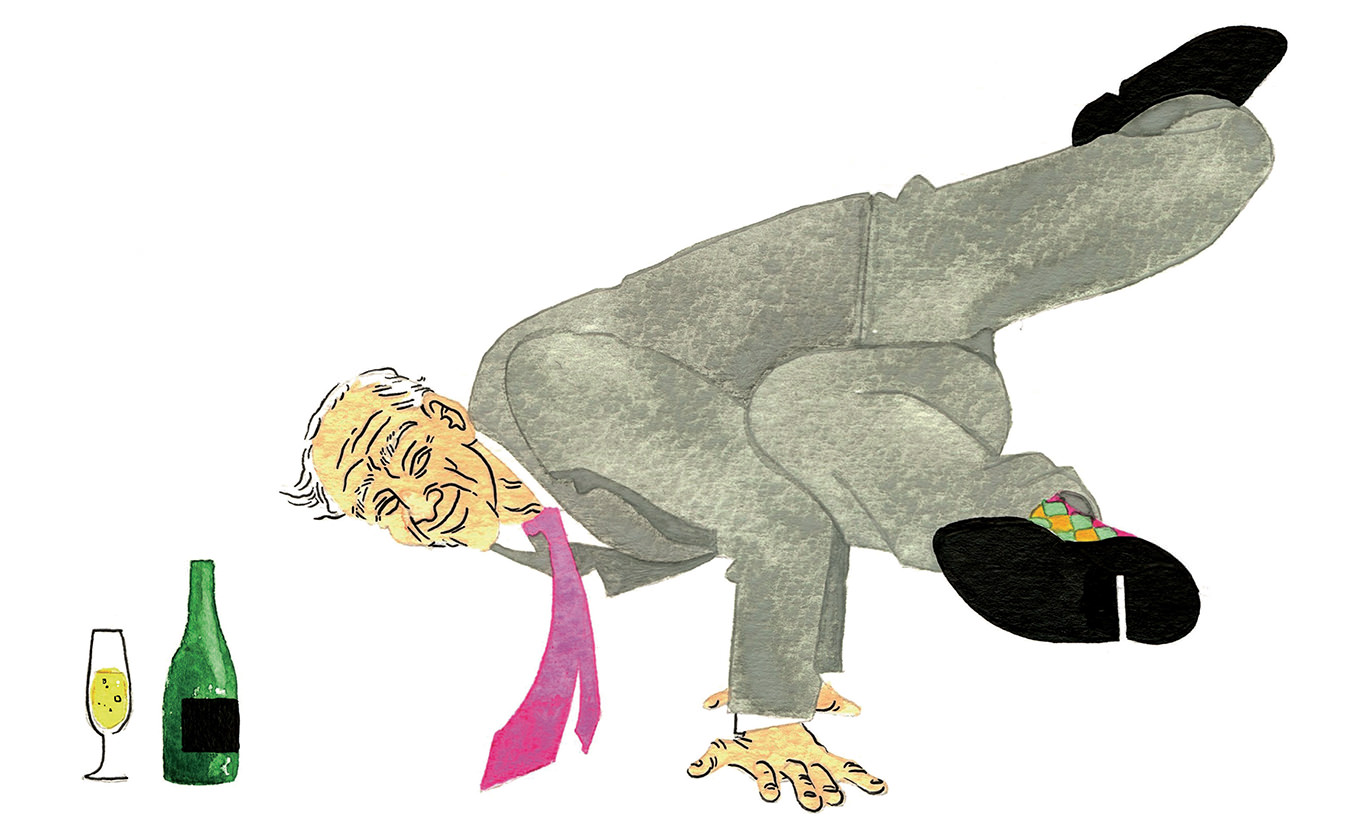The World’s Most Travelled Person
On a trip.

Illustration by Jesse Lefkowitz.
Imagine for a moment the Earth’s political history as an out-of-control Veg-O-Matic that has sliced and diced the continents and far-flung archipelagos into 872 small administrative pieces called countries, colonies, islands, states, provinces, or, in one case, the dozens of regional oblasts that form Russia. Now imagine there’s a global adventurer’s continuum that begins, at one end, with the world’s most lethargic and non-dead dull person. His belly is probably big and his sense of adventure extends no further than discovering the long-lost jar of Cheez Whiz misplaced among the condiments in the fridge door. This continuity extends outward from there to the Las Vegas conventioneer, to the international businessman, and—given the resources of a lot of money and a lot of time—to the extreme, competitive world traveller. Out there at the furthest end of this global continuum, alone and covering 300,000 kilometres a year, is 47-year-old Charles Veley. By spending millions of his dot-com dollars over eight years in pursuit of a bizarre goal, Veley can lay claim to being the grand pooh-bah of adventurers: the world’s most travelled person. In Veg-O-Matic terms, Veley has been to 827 of the 872 officially listed sliced-and-diced places on Earth.
Now I share with Veley some of the odd attributes of the extreme traveller. I, too, collect nations. I sometimes go to places because they’re there. The annotated world map above my rolltop desk testifies I’ve been to 100 countries. And by then adding up the smaller jurisdictional fragments—49 American states (missed Nebraska), 12 Canadian provinces and territories (missed Prince Edward Island), plus a lot of lonely outposts like the Faroe Islands, Wake Island, and Antarctica’s South Shetland Islands—I can count 249 places on the Most Traveled People (MTP) list. But that’s so far short of Veley’s accomplishment that it’s embarrassing. It’s like running a marathon and coming in last. I’ve collected, I admit, the relatively easy-to-pick, low-hanging fruit.
For true traveller immortality, you need—metaphorically—a ladder made of very large-denomination dollar bills to climb into the stratospheric zone where Veley and his 12,000 or so MTP co-competitors operate. It is not cheap, and could be dangerous, to get to the extraordinarily remote and uninhabited Heard and McDonald Islands, located 4,000 kilometres southwest of Perth, off Antarctica. At the world’s frontiers, you just never know. You can shout, “Carpe diem!” from the penthouse railing on your departure. And an RPG-armed Somali pirate can later shout, “Carpe diem!” as your leaky hired skiff approaches, inbound for Eritrea.
Oh, and there’s one more necessary thing, something less tangible than wealth or luck and yet essential for increasing the odds of world-travel celebrity. You need something that lies between courage and its intimate bedmate, shamelessness. You need, in a word, obsession.
Obsession, I realize, has a bad name. It evokes unwashed hoarders whose apartments are filled with dumpster-culled junk and yellowing newspapers; or Imelda Marcos’s collection of 3,000 pairs of shoes. But there’s another kind of obsession that’s less pathologic. It’s the quest. I once met a 72-year-old woman in the mountains above British Columbia’s Cathedral Lakes who appeared suddenly from below the ridgeline trail. She had a grin on her face and she confessed she’d climbed down a talus slope there because she thought she’d seen a rare flower. Her goal before she died, she explained, was to see every wildflower in Canada—blooming. “If you have an obsession,” she added with utter certainty, “you have a wonderful life.”
This was an observation so disturbing that I actually paused to write it down. Could obsession really produce a wonderful life? The more I considered what seemed at first a ridiculous contention, the more I saw that every great achievement requires a ferocious focus that swerves around pitfalls, doubts, and sheer laziness—in pursuit of something exquisite. Collect baseball cards? Then you want the 1909 Honus Wagner card. Collect Hummel figurines? Then you want Apple Tree Girl 141. Collect summits? Then Mount Everest is merely a way station on your way to other peaks. Everything else becomes distraction. To the right eyes, the world is made of wildflowers.
There’s something less tangible than wealth or luck, and yet essential for increasing the odds of world-travel celebrity. You need something that lies between courage and its intimate bedmate, shamelessness. You need, in a word, obsession.
I realized that my obsession was global adventure. It began in childhood with stamp collecting and the monthly arrival of National Geographic. It was later nurtured by years of youthful wandering, and my subsequent work as a journalist. Twenty years ago, this fascination led me to Parke Thompson and John Clouse, two itinerant American lawyers who were, at that time, in a race to become the first person to go everywhere. Each was one destination shy of the Los Angeles–based Travelers’ Century Club (TCC) list of 309 (currently 321) places that then constituted everywhere on Earth. Thompson once told me, “As the list gets shorter, the difficulties get harder. And the expenses get terrific. I’d spend a day … or a few days in a place and move on. My wife couldn’t stand that. She wanted to stay.” And Clouse (who passed away in 2008) admitted to me that he’d churned through seven wives in his successful effort to be listed in the Guinness World Records book as the world’s most travelled person.
I suspect that neither Thompson nor Clouse nor Veley would, despite their various marital difficulties, accept that their travelling obsession could be classified as dromomania—an uncontrollable, psychosomatic urge to wander. Each told me his travels were propelled by curiosity, not compulsion. Each said the world is an interesting place; and it gets more interesting the farther you veer from the safe and familiar. Does Turkmenistan really have the world’s worst food? Is Lord Howe Island the best place on Earth? Is it even possible to get to Scott Island?
Veley knows the answers to these—and hundreds of other obscure questions—as a result of his 4,830,000 kilometres of global peregrinations. To his mind, though, he’s simply an “extreme traveller”.
Veley’s travel affliction had its roots in childhood when, seated at the wheel of the family’s car, he’d utilize the Rand McNally North American Road Atlas on imaginary journeys from his Brooklyn home. He was six. He didn’t start full-time adventuring, however, until 2000, when—at the height of the American dot-com boom—his IT company, MicroStrategy, went public, and Veley became a multi-millionaire. Suddenly fabulously wealthy, young, overworked, and alerted by an inflight magazine about the Travelers Century Club, Veley and his new wife, Kimberly, set out on what became a year-long global wandering. The goal wasn’t to collect countries at first, but Veley soon realized that if they flew in increments—rather than non-stop—they could quickly close the gap between themselves and Clouse. In less than three years, he’d reached 300 places on the TCC list. And Veley, by then fully obsessed, found himself wondering how to get to places so remote (British Indian Ocean Territory) or so dangerous (Chechnya) or both remote and dangerous (Bouvet Island, a volcanic territory of Norway) that his wife chose to step away from the seductive vortex of movement for the settled, domestic life of central California.
But once Veley had matched Clouse and completed the entire TCC list, he was, like the chicken that crossed the road, forced to ask: What’s next? So, undaunted, he began compiling what has become the far more expansive 872-place Most Traveled People list. It draws on other adventurers’ world listings and Veley’s own arbitrary selection of largely unheralded places. These encompass scores of obscure mid-ocean rocks, reefs, and atolls; the 31 states and one federal district of Mexico; the 20 regions of Italy; and the 26 Antarctic and sub-Antarctic territories. Unfortunately, all this list making—and the inevitable bickering that ensued—has, in the end, convinced adjudicators at Guinness World Records that no comprehensive, agreed-upon list exists, so in 1999 they eliminated the book’s most travelled man category.
In a way, this is an ironic commentary on the quest to go everywhere. Your listed island is my unlisted rock. Or put another way: When does a wildflower become a weed? There is, of course, a danger in any competition of the subjective, on which a lot of time and editorial hand-wringing is spent. Most beautiful person? Best restaurant? Finest golf course? Superlatives are, all too often, glamorous conceits.
Veley is still pursuing his goal of completing the MTP list but admits his availability has dwindled a bit as he has gone back to working full time. Last year, he told me, he got to check off three remote Caribbean islets, including tiny, uninhabited Navassa Island off Haiti. Its solitary attraction is guano. To reach the island, he was forced to swim through a quarter-mile of surf. But once beneath Navassa’s wave-battered, 10 metre-high cliffs, he discovered that a frayed, hanging rope offered the only method of access. He didn’t trust it. So he swam laterally, fearing a rogue wave would push him against the sharp rock face nearby. Exhausted, he finally found a perch and claimed success. But he acknowledged that this small victory was accompanied by an unanticipated thought: “Maybe I’m getting too old to do this.”
Clouse was in his 60s when he achieved fame in the early 1990s as the original “world’s most travelled man”. That leaves Veley with 15 or so years to supersede himself and meet the goal he established with the MTP list. He knows he has challengers to his current title, but admits that, since his recent divorce, parental responsibilities—with three young kids and a home to maintain—have assumed new importance. Priorities change. Work intrudes. Fatherhood matters. It is, after all, just a race. Still, he regularly applies to Chinese authorities to be permitted to land on the disputed Paracel Islands in the hydrocarbon-rich South China Sea. But geopolitics keep preventing that. And then there’s unimaginably bleak, four-hectare Scott Island, surrounded by permanent sea ice in Antarctica’s stormy Ross Sea. “It’s not on the way to anywhere,” Veley once told me, in frustration. “You can’t even approach it.” But difficulty and danger have seldom stopped him. After all, every obstacle is also an opportunity.




